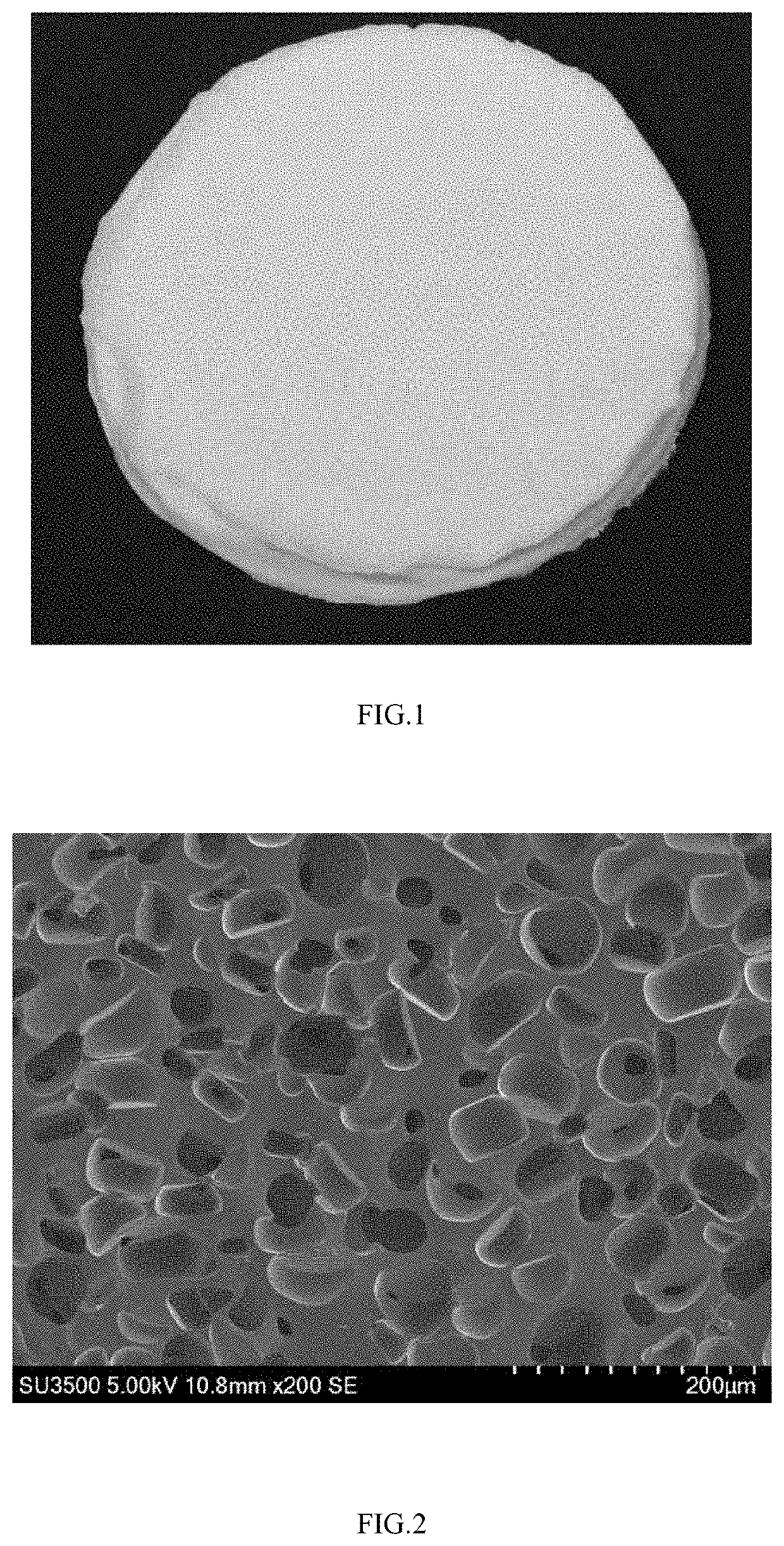Method to prepare polymer materials with interlocked porous structures by freezing and demulsification of emulsion
a technology of porous structure and polymer material, which is applied in the field of manufacturing of porous polymer materials, can solve the problems of delayed supply of medical masks, poor control of porous structure of polypropylene fiber, and use of chemical disinfectants such as ethylene oxide to disinfect prepared masks, etc., and achieves the effect of reducing the mechanical properties of used polymers, large fluid flux, and high temperatur
- Summary
- Abstract
- Description
- Claims
- Application Information
AI Technical Summary
Benefits of technology
Problems solved by technology
Method used
Image
Examples
example 1 (
Using Diacetone Acrylamide and Adipic Acid Dihydrazide to Form Crosslinking Network)
[0039]The used raw materials and their ratios:
ReagentDosage / gReagentDosage / gPrimer liquid:Deionized water80.00Emulsifier0.40A-980Ammonium0.30Emulsifier0.60persulfateA-6828Sodium Bisulfite0.30Sodium0.35bicarbonateButyl acrylate8.00Pre-emulsion liquid:Deionized water80.00Emulsifier1.00246Ammonium0.32Emulsifier1.00persulfateA151Emulsifier 1023.00Diacetone1.00acrylamideEmulsifier T-403.00Acrylonitrile15.00Butyl acrylate88.00Ethyl acrylate90.00Initiation system:Sodium0.32Sodium0.50BisulfiteDodecylSulfonateDeionized water15.00Post-treatment liquid:Ammonia1.50Adipic0.60acidhydrazideDeionized water7.00
[0040]Preparation Steps:
[0041](1) The primer was prepared in a reaction container according to the formulas, and stirred at 60° C. for 20 minutes until appearing light blue color. Then, according to pre-emulsion liquid formula, emulsifiers and other additives were added to the water phase, and stirred until com...
example 2 (
Using Glycidyl Acrylate and Triethyltetramine to Form Crosslinking Network)
[0045]The used raw materials and their ratios:
ReagentDosage / gReagentDosage / gPrimer liquid:Deionized water90.00Span 800.40Dibenzoyl0.50Tween 600.60peroxideEthyl acrylate8.00Sodium0.35bicarbonatePre-emulsion liquid:Deionized water80.00Tween 403.00Emulsifier 1023.00Glycidyl5.00acrylateButyl acrylate80.00Ethyl92.00acrylatePost-treatment liquid:Ammonia1.50Triethyltetra-3.00mineDeionized water7.00
[0046]The total preparation steps are similar to those in Example 1.
[0047](1) The primer was prepared in a reaction container according to the formulas, and stirred at room temperature for 20 minutes until appearing light blue color. Then, according to pre-emulsion formula, emulsifiers and other additives were added to the water phase, and stirred until completely dissolved. Next, other monomers were added to the previous liquid and emulsified under large shearing rate to form a stable pre-emulsion liquid. Finally, after t...
example 3 (
Using Glycidyl Methacrylate and Dithiothreitol to Form Crosslinking Network)
[0051]The used raw materials and their ratios:
ReagentDosage / gReagentDosage / gPrimer liquid:Deionized water100.00Emulsifier A-0.40980Azobisisobutyronitrile0.80Emulsifier 2461.00Methyl methacrylate10.00Sodium0.10carbonatePre-emulsion liquid:Deionized water50.00Emulsifier 2461.00Azobisisobutyronitrile0.35Emulsifier1.00A151Emulsifier 1023.00Glycidyl5.00methacrylateMethyl acrylate100.00Methyl50.00methacrylatePost-treatment liquid:Sodium acetate5.00Dithiothreitol5.00Deionized water10.00
[0052]Preparation Steps:
[0053](1) The primer was prepared in a reaction container according to the formulas, and stirred at 40° C. until appearing light blue color. Then a stable pre-emulsion liquid was made according to the pre-emulsion liquid formula. The pre-emulsion liquid was added into the reaction container by dripping after appearing light blue color, and the total process was 6 hours.
[0054](2) 10 minutes after the start of t...
PUM
| Property | Measurement | Unit |
|---|---|---|
| freezing temperature | aaaaa | aaaaa |
| light wavelength | aaaaa | aaaaa |
| temperature | aaaaa | aaaaa |
Abstract
Description
Claims
Application Information
 Login to View More
Login to View More - R&D
- Intellectual Property
- Life Sciences
- Materials
- Tech Scout
- Unparalleled Data Quality
- Higher Quality Content
- 60% Fewer Hallucinations
Browse by: Latest US Patents, China's latest patents, Technical Efficacy Thesaurus, Application Domain, Technology Topic, Popular Technical Reports.
© 2025 PatSnap. All rights reserved.Legal|Privacy policy|Modern Slavery Act Transparency Statement|Sitemap|About US| Contact US: help@patsnap.com



